Pay Gap Calculator
You may have wondered at some point in your life: do I earn as much as another person in a similar profession with similar work experience? With this calculator, you can have some insight into how your wage depends on your sex, race, and occupation in general. This calculator is based on the detailed statistics for the US, but if you want to check the general gender pay gap for other countries, check out our last year's gender wage gap calculator.
Countless things influence the course of your life from when you see daylight for the first time. The country or culture you were born into, or the wealth and social position of your family, all actively affect your life. Naturally, your ambitions and capabilities are also important factors, though there are other innate features, such as your ethnic background or race, that may also be influential. Still, there is one more trait that plays a vital role in the path of your career – and it's your gender.
Different earnings for men and women, that is, the gender wage gap, is a long-lasting problem in our society. Today the average woman in full-time employment earns around 81 cents for every dollar a man does (US Bureau of Labor Statistics, 2018). This means that if you are a woman and your wage is, let's say, $800 per week, you may earn $152 less in a week, which is approaching $8,000 in a year!
Why is that? In our article, you can read about the possible reasons and the background of this issue. We also give you advice and suggestion on how to help to close the gap.
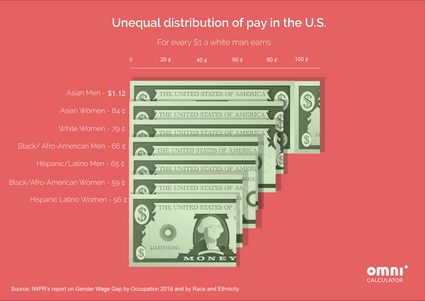
The gender equality and pay gap calculator
Almost a century ago, gender equality and woman's rights appeared in public awareness. Some may think that after so many years, we have finally arrived at this mythical gender equality, but this is not so. We'd like to leave here just a couple of explicit examples:
-
Let's start with literature: a bit more than 20 years ago, a woman writer finished the manuscript of a book. She was looking for a publisher, but twelve publishing houses rejected the manuscript. Finally, she found one, but her publishers suggested that she should change her first name to initials only – to hide her gender.
Her name was Joanne Rowling, the author of the Harry Potter series.
-
Let's look at actors from the red carpets of Tinseltown, now. Take of the top ten highest-paid female actors and an analogical list for actors. You could assume that the earnings should be more or less similar.
Unfortunately, it's not the case. Last year's highest-paid actress – Emma Stone – earned $26 million, while the top on the men's ranking – Mark Wahlberg – earned $68 million. Not jumping to conclusions, you could think it's just an isolated incident, as Wahlberg is also winning in "the most overpaid actor" category. Again, you are mistaken: Emma, with her earnings, would not even appear on the top 10 men's list. If you sum the earnings from both lists, the top ten highest-paid actresses earn less than 25% of their male counterparts. As Natalie Portman said in a 2017 interview: Compared to men, women make 80 cents to the dollar in most professions. In Hollywood, we are making 30 cents to the dollar.
-
Perhaps in sports, the situation is better?
We won't compare the earnings of the best basketball players of two genders, as you can argue that men's sport is much more popular and thus creates more revenue (still, the differences are as huge as less than one cent for top women per dollar earned by best men doesn't seem fair). We're not mentioning the in the world (women: 0). Instead, let's take a closer look at tennis: the earnings of the differ substantially (80 cents for females for each dollar earned by male players), although the grand slam offered equal prize money for men and women, so tennis is a leading sport in terms of gender equality. Also, not so long ago , despite doing comparable work (and even generating more revenue than men), was paid only a quarter of men earnings. The team finally resolved the pay dispute with the federation, but why did they have to fight for it?
Even though these examples come from the world of stars and celebrities, we can't forget that gender inequality and the pay gap is a real thing, and it applies to all of us.
With our pay gap calculator, you can check what your earnings would be if you were of the opposite gender or had a different skin color. Of course, it's an approximate tool that is generalizing a lot: we're not taking into account many factors influencing earnings, such as education, location, position, experience, performance, etc.
Ideally, you should compare your earnings with a person of different gender / race / ethnicity but doing exactly the same job, having the same results, experience, and so on – but it's unfortunately impossible, so we're making the approximations based on the U.S. Statistics. More details about data and calculations may be found in the Disclaimers section.
What happens when you get a raise in your wage? The first thing you would want to do is determine the new salary. For that, check out our pay raise calculator.
Why do women earn less?
There are many explanations for the gender pay gap. Even though some reasons for the difference are known and can be measured, this does not give the full picture. As a result of decades of research and investigations, the most common reasons are the following:
-
Marriage and motherhood
Women have a considerable burden on their shoulders during the time of maternity and parenting, which can strongly influence their careers. For example, women often leave a high-paying job when they have a child as they prefer the more traditional gender role of child care, or simply don't have other choices as they face severe difficulties when they re-enter the labor market after maternity leave.
-
Unequal participation in household chores
Generally, women do more housework than men. Traditional female tasks are more time-consuming (for example, cooking or ironing) and are daily basis chores, in contrast to the more "masculine" tasks (such as gardening or repairing), which have a more flexible schedule and are more occasional. As a result, many women take a "second shift" when they arrive home which contributes to gender inequality.
-
Balancing work and family responsibilities
It is generally more difficult for women to harmonize their working schedules with family responsibilities. Still, women are usually the ones devoting more time to family – and it's more expected from them.
-
Different attitudes and approaches towards material benefits
Women often have lower salary expectations, and they usually take a more moderate position in salary negotiations. Besides, in many cases, women care more about social values than material benefits or authority, which are more important for men.
-
Differences in occupations between men and women
Because of traditions or personal characteristics, there are many occupations where gender segregation is common. For example, more men work in managerial positions, full-time positions, and positions with more authority and promotional opportunities.
-
Wage discriminations and stereotypes
Multiple studies have found that rational factors cannot explain a considerable part of the pay gap. As an example, have a look at describing the study about hiring women in science, where potential employers were assessing the almost identical résumés – the only difference was a female or male name on it. Despite the exact same qualifications and experience, the man was perceived as more competent and more valuable, and he was more likely hired. Moreover, he was offered a higher salary and more mentoring opportunities! This part of the gap definitely is the result of gender discrimination.
Now you know some of the most important reasons behind the gender wage gap. You can read further and get some ideas about why it is so crucial for our society.
Might we interest you in our annual income calculator?
Why should we care about the gender wage gap?
The first and probably the most important answer is discrimination. Although the Equal Pay Act of 1963 outlawed wage discrimination based on sex, there is still a sizable part of the gender wage gap which can't be justified. Discriminating against anyone on their gender or any other natural feature is morally wrong. It is harmful to a person, a family, and society as a whole. Have a look at this heart-warming (The Finance Sector Union of Norway), prepared for Women's Day 2018.
Besides discrimination harming a person's dignity, the gender wage gap has a considerable financial impact on an individual's life and family. Gender wage gap:
-
Cuts not only income for women but for the whole family as well;
-
Lowers benefits linked to salary, especially retirement savings;
-
Is extending the working years of women before retirement;
-
Can make women economically dependent; and
-
It Can make it harder for women to pay for education and child care and to accumulate wealth, for example, to buy a house.
There are more indirect reasons why we should care about the gender gap. Most experts agree that better gender balance in education, employment, and wages would bring many economic benefits:
-
It would cut the poverty rate of working women by half (Institute for Women's Policy Research);
-
It would add an extra income of $512.6 billion for the US economy (Institute for Women's Policy Research);
-
It would speed up economic growth by 5 percent in the US (IMF);
-
Involving women in higher management would boost company earnings (IMF);
-
It would increase tax revenues; and
-
Studies also show that improving gender equality has beneficial spill-over effects on other parts of the economy.
The lifetime wage gap in the United States
We already gave you a hint about how vast a gap can emerge in yearly incomes between men and women. But let's see this for the whole lifetime or career. On average, the lifetime wage gap loss for women in the United States is as high as $403,440 (National Women's Law Center), which is enough money to buy a house! Of course, this number depends highly on other factors, such as ethnicity or career path, but it gives you a general view of how serious this issue is. Besides, the size of the gap also depends on where you spend your life: in Louisiana, on average, a woman during her whole career may lose more than $600,000 compared to the loss of around $200,000 in Florida, which is still a massive amount of money!
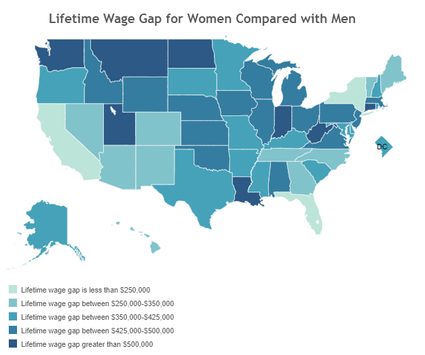
Besides the location, the career wage gap also depends on the educational level: women with a college degree or higher may lose more than $700,000 over a 40-year career compared to the loss of nearly $300,000 for women who did not finish high school. Also, the type of occupation has a great influence: the widest gaps are in finance and management, and the smallest ones are in construction and maintenance.
One explanation why women can lose such an enormous amount of money is that they generally receive lower salary increases by promotion or a new job. These differences pile up throughout their career, eventually reaching an immense value.
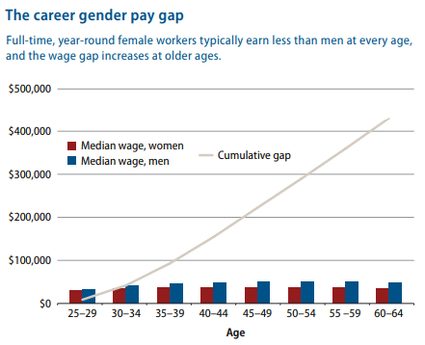
Moreover, wage differences emerge already in the teenage labor years, which contributes to a higher lifetime wage gap. But the considerable gender wage gap in such an early stage of life has a more alarming signal. Since common explanations for inequalities as working experience, education, or motherhood, do not exist among young workers, it suggests that gender-based discrimination is a real problem for society.
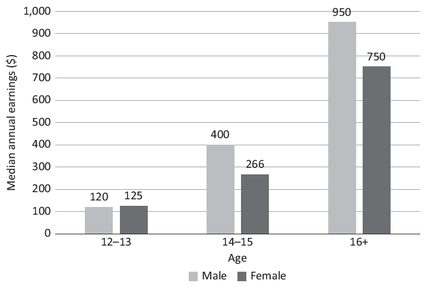
Gender wage gap in the long term
The earliest data on the gender wage gap came from 1820, when a woman earned only 35 percent of a man's income (Wade and Ferree, 2015). Although the gap has narrowed considerably over the centuries, the gender wage gap is still a striking problem in society. Besides, in the last two decades, the gap has been about the same size.
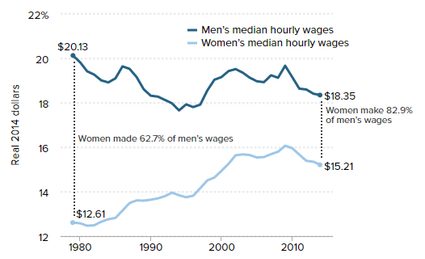
What can we do to eliminate the gap?
It doesn't matter if you are a man or woman, regardless of your occupation or position; we can all help to close the gender pay gap. As you have seen, balancing payments of different genders is favorable for the whole society, and even a little step toward gender equality positively affects our lives. In the following paragraph, you can read some suggestions and ideas about how you can contribute to resolving this problem.
-
From a personal or family point of view the below points may give you some hints on the ways of eliminating the pay gap:
-
Balancing house chores and responsibilities between family members
An equal share of housework and other family responsibilities can lessen a woman's burden.
-
Involving men in parenting
More engagement of men when their babies are born, for example, paternity leave, can help mothers to keep up their career path.
-
Women should take a more demanding position during wage negotiation or promotions
"A journey of a thousand miles begins with a single step" – women should stand up for their values and be confident during wage negotiations when they enter the labor market from the very beginning.
-
Reveal wage discriminations
Speaking up and expressing concern can also stop morally wrong behavior.
-
-
Business and educational institutions could help in closing the gap by:
-
Encouraging women and men to try occupations that are not traditional for their gender;
-
Part-time and flexible working arrangements;
-
Businesses (and governments) should do much more to ensure fair pay and help women to achieve economic equality;
-
Regular review of compensation schemes can ensure wage equality;
-
Updating labor standards;
-
Changing the culture of work to value work-life balance; and
-
More transparency in compensation data.
-
-
Also the Government has a crucial role in narrowing the gender pay differences by:
-
Improving parental and family leave policies;
-
Enforcing existing fair pay laws and initiating further laws to guarantee more equality;
-
Monitoring the labor market and working environments;
-
Provide incentives and guidance for employees and employers;
-
Improving education, training, and research to enhance gender equality; and
-
Promoting the social benefit and social safety net.
-
Disclaimers
The hypothetical salary was calculated as the multiplication of the pay gap (in percentages) in the specified group and actual earnings entered by the user.
The calculator relies on the data from and . We based our calculations of the pay gap on the 2018 median weekly earnings of full-time wage and salary workers for each gender-race/ethnicity group, for each occupation category separately.
Other factors influencing the pay gap of the respective groups, e.g., age, education, position, etc., were not taken into account due to the shortage of data.
Accordingly, the individual results correspond to a median representative of each specified group that might diverge due to the omitted variables.
References
-
Arons, Jessica (2008). Lifetime Losses – The Career Wage Gap.
-
Bertrand, Marianne; Goldin, Claudia and Katz, Lawrence F. (2010). Dynamics of the Gender Gap for Young Professionals in the Financial and Corporate Sectors.
-
Besen-Cassino, Yasemin (2018). The Cost of Being a Girl – Working Teens and the Origins of the Gender Wage Gap.
-
Davis, Alyssa, and Gould, Elise (2015). Closing the pay gap and beyond – A comprehensive strategy for improving economic security for women and families.